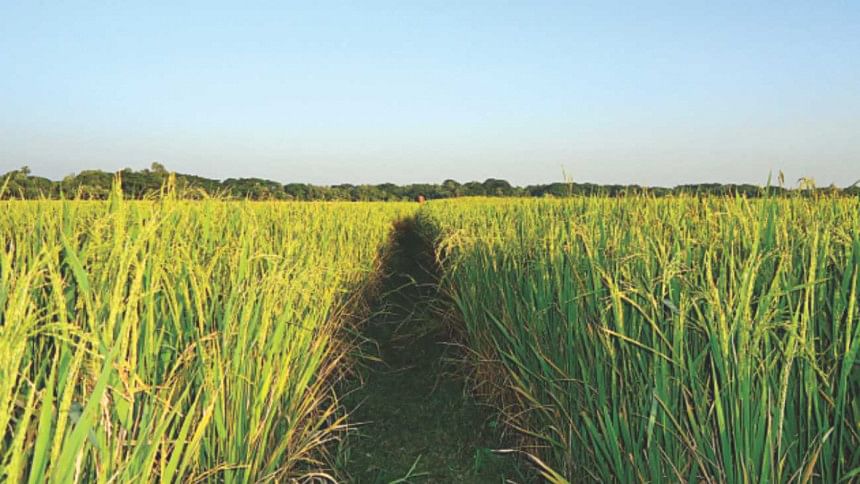Aman output likely to fall

♦ Aman cultivated on 58 lakh hectares this year
♦ 1.3cr tonnes of Aman output expected
♦ Overall rice shortfall will be 14 lakh tonnes
Bangladesh is bracing itself for another less productive rice season as the United States Department of Agriculture predicts decline in acreage and yield of Aman.
Aman is the most important rice season in the country after Boro.
A USDA field report has forecasted 1.3 crore tonnes of Aman production this year. It is 3.5 lakh tonnes less than last year's yield.
The recent report has also noted fall in Aman acreage from last year's 59 lakh hectares to 58 lakh this year.
Overall, the USDA has projected 3.31 crore tonnes of rice output in the country this fiscal year, down by 14 lakh tonnes from last year's.
Officials at the agriculture ministry, however, preferred not making any projections right away.
Talking to The Daily Star yesterday, Agriculture Minister Matia Chowdhury said, "Only six percent Aman has so far been harvested. I don't like to make a projection at this stage. A lot depends on the weather."
She expressed optimism that the rice output would be moderately good as farmers tried hard to recoup flood losses during the very early stage of Aman transplantation.
Thanks to the rain last month and subsequent cooler weather, the pest infestation in Aman has largely been subdued as well, Matia added.
Farmers are going for a full-swing harvesting of Aman, the rain-fed monsoon grain that typically contributes 38 percent to the country's yearly rice output, within a week.
Earlier, the food ministry said the country had lost 20 lakh tonnes of rice due to the fungal attack -- blast -- and flash floods in north-eastern haor region during the last Boro season.
According to the Ministry of Disaster Management and Relief, the second spell of flood this year has severely affected 208 upazilas and nearly 8,260,000 people.
The agriculture sector suffered the most. The government estimates that flooding completely washed away over 1 lakh hectares and partially damaged another 5 lakh hectares.
The floods and the blast prompted the government to go for large-scale rice import from Vietnam, Cambodia, Thailand, India and Myanmar. The private sectors are also already on an import spree with rice import hitting the all-time high of 14 lakh tonnes in just first four months of this fiscal year.
Prices of coarse rice that had peaked in July-August period have come down but are still high by at least 30 percent, comparing to last year's market prices of the staple.
The USDA and the agriculture ministry attributed the losses faced by farmers to floods. They, however, said crop losses would be "nothing alarming" as farmers tried hard to recoup them by going for late and secondary planting.
Officials at the Bangladesh Rice Research Institute and the International Rice Research Institute also lauded the farmers for going for rice varieties that are submergence-tolerant and can withstand 15 to 17 days of stagnant water.
THE USDA REPORT
The USDA report said, "The impact [of flood] on food supplies and livelihood of farmers has been dramatic. Those estimates may actually be conservative: according to the Humanitarian Coordination Task Team [HCTT], the area of crop damage was 650,000 hectares.
"Of the damage, the crops most affected were Aus, Aman, Aman seedbed, seedling, jute, and vegetables. The secondary flooding also destroyed freshly planted Aman paddy and seedbeds, which dealt a fresh blow to farmers.
"The resultant shortage of seedlings caused a price shock and in turn replanting of Aman rice were down sharply from market needs: some farmers switched to early winter crops instead of the costly seedlings," the report said.
Late planting and the use of less productive local variety rice seeds would result in poor output, the USDA forecast says.
It also noted that though the transplanting of Aman was completed quite late in the season owing to an atypical monsoon this year, favourable weather for growth of Aman rice indicated a likely good harvest.
The USDA report adds, "Massive amounts of crops lost to flooding imposed economic hardship on millions of farmers and households. The flooding affected 34 out of the 64 administrative districts of the country.
"Heavy late monsoon rains in the upstream provinces of Assam, Meghalaya and Arunachal in India caused flooding in the north-eastern districts of Bangladesh."

 For all latest news, follow The Daily Star's Google News channel.
For all latest news, follow The Daily Star's Google News channel. 








Comments